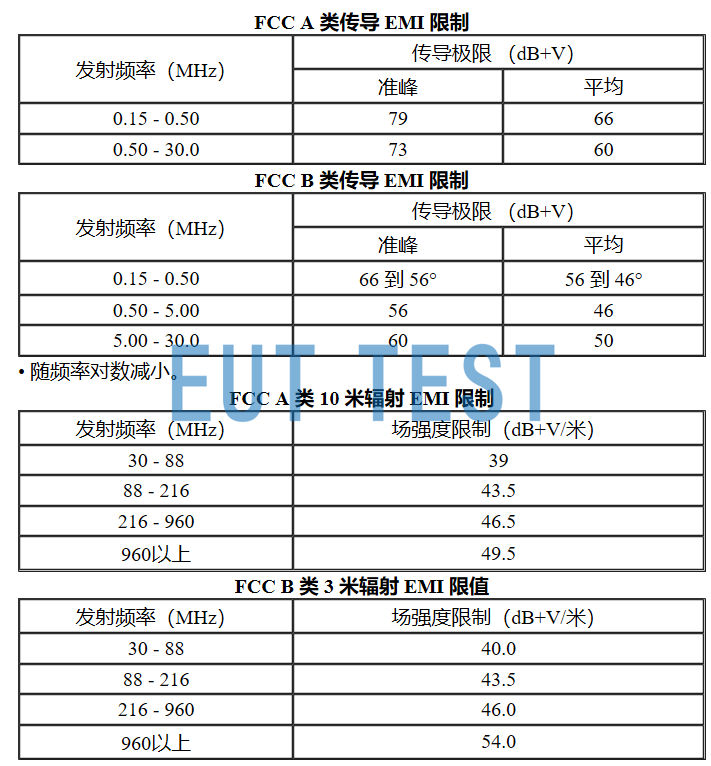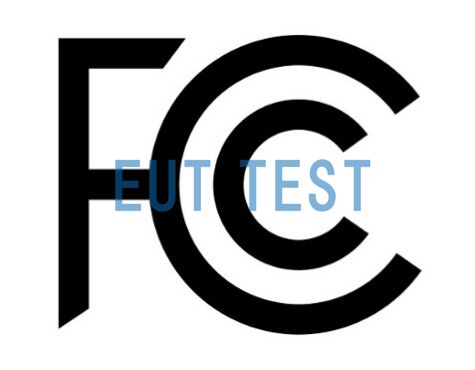Federal Communications Commission FCC Introduction:
The Federal Communications Commission (FCC) regulates all commercial (i.e., non-military) sources of electromagnetic radiation.The FCC Rules and Regulations, Chapter 47, Part 15, set forth limits on radiation from intentional and unintentional sources.

Federal Communications Commission (FCC)
The Federal Communications Commission regulates intercontinental and international communications in the 50 states, the District of Columbia and the United States territories through radio, television, wire, satellite and cable. As an independent agency of the United States Government with congressional oversight, the Commission is the federal agency responsible for implementing and enforcing United States communications laws and regulations.
FCC part 15 Standard Source:
In the United States, the Federal Communications Commission (FCC) regulates all commercial (i.e., non-military) sources of electromagnetic radiation.The FCC Rules and Regulations, Chapter 47, Part 15, set forth limits on radiation from both intentional and unintentional sources.Unintentional sources regulated by the FCC include any unintentional radiator (device or system) that generates and uses timing pulses at a rate in excess of 9,000 pulses (cycles) per second and uses digital technology. ) and uses digital technology. This includes virtually every product that uses a microprocessor, including computers, computer peripherals, electronic games, office equipment, and point-of-sale terminals. Certain categories of electronic equipment are particularly non-compliant with Part 15 requirements, including automotive, electrical and industrial, scientific or medical equipment. It is illegal to sell or advertise for sale any product regulated under Part 15 until its radiated and conducted emissions have been measured and found to be in compliance, without first making an FCC certification.
Classification of the device under test that requires FCC authorization:
When FCC part 15 is certified, 47 CFR part 15 specifies electronic and electrical equipment that can emit RF energy and that may cause RF interference to equipment operating in the frequency range of 9 kHz to 3000 GHz.
The devices under test were classified into three categories:
unintentional launch
Unintentional emissions are defined as products that intentionally generate RF energy to send signals within the product or through connecting wires, but do not emit RF energy wirelessly, such as by radiation or induction. Most unintentional emissions must be authorized under the supplier's Statement of Conformity (SDoC) process. Examples include the following products:
- LED light bulb
- coffee maker
- USB flash drive
- wired mouse
- External switching power supply
intentional launch
Intentional emission is defined as a device that generates and emits RF energy by radiation or induction. This includes products under test with Wi-Fi, 3G, 4G, 5G, Bluetooth, LTE or active RFID. Most of the intentional sources listed below must be authorized under a certification program.
- Bluetooth speaker
- Active RFID tags
- smartphone
- wireless microphone
- wireless router
chance launch
Accidental emissions generate or emit RF energy, even if it is not intentionally designed to do so. They are usually components that are integrated into a device and are classified as either unintentional radiators or intentional emissions. Example:
- electric motor
- Mechanical illuminated switches
Incidental launches do not require equipment authorization. But they must still comply with the general operating conditions set forth in 47 CFR Part 15. This means you need to reduce the risk of possible harmful interference by using good engineering practices.
No FCC authorization is required for the classification of the device under test:
For FCC part 15 certification, 47 CFR part 15 does not require authorization for the following types of equipment.
Homemade equipment
Under 47 CFR part 15.23, if the product complies:
- unlisted
- It's not made of kits.
- Built-in quantity of no more than five for personal use
An individual who manufactures homemade equipment may not be able to fully evaluate the equipment for compliance with FCC requirements. Therefore, that individual should utilize good engineering practices to ensure that the equipment complies with the relevant requirements to the extent possible.
Power Line Carrier System (PLCS)
Powerline carrier systems are exempt from device authorization.
However, they are still subject to several requirements under 47 CFR Part 15.113:
- The operating frequency shall be maintained in the frequency range of 9 kHz-490 kHz.
- The system shall operate on an "unprotected, interference-free basis".
- System equipment should be operated at the minimum power possible.
Other exempt instruments
47 CFR Part 15.103 lists several devices that are exempt from authorization, for example:
- Digital devices dedicated to appliances (e.g., clothes dryers).
- Specialized medical digital equipment.
- Joystick controllers or similar devices that do not contain digital circuitry.
- Digital devices with power consumption below 6 nW.
digital product
47 CFR section 15.3 divides digital products into two categories:
- Class A equipment is equipment sold in a commercial, industrial or business environment.
- Class B devices are for home use.
Class A equipment does not include equipment marketed for public or domestic use.
Class B equipment includes, but is not limited to, personal computers and calculators.
The Class B limits are more stringent than the Class A limits, as shown in the table below.The radiated and conducted EMI test procedures are defined in ANSI Standard C63.4.Part 15 of the FCC Rules and Regulations regulates only electromagnetic radiation, and there are currently no FCC rules regarding a product's immunity to electromagnetic fields.

FCC PART 15 Conducted and Radiated Nuisance Test Limit Requirements for Class A and Class B Equipment
The EMC requirements for products used by the U.S. military are contained in a document called MIL-STD-461. This standard can be applied to a variety of systems, including everything from power tools to workstations. Unlike the FCC regulations, MIL-STD-461 includes limits for radiated and conducted immunity as well as radiated and conducted emissions.
FCC part 15 certification citation standards:
47 CFR part 15.31 incorporates by reference several ANSI standards that outline measurement procedures for assessing compliance with technical requirements. Below, we briefly describe some of the standards.
ANSI C63.4 - Measurement of radio noise emissions from low-voltage electrical and electronic equipment in the range 9 kHz to 40 GHz
- This standard establishes guidelines for the measurement of noise emitted from RF signals and unintentional emissions, including electrical and electronic equipment operating in the bandwidth from 9 kHz to 40 GHz.
- The specifications of the standard are harmonized with other national and international standards to the extent possible.
- ANSI C63.10 - Compliance Testing of Unauthorized Wireless Devices
- This standard covers test procedures for various types of intentional emissions, for example:
- cordless telephone
- Medical unlicensed wireless devices
- intrusion detector
- This standard does not include test methods for unauthorized wireless devices that are already covered by other published standards.
ANSI C63.17 - American National Standard Methods of Measurement for Electromagnetic and Operational Compatibility of Unauthorized Personal Communications Service (UPCS) Equipment
This standard covers test methods for verifying the electromagnetic and operational compatibility of certain types of intentional emissions, for example:
- Broadband voice equipment
- data device
- The standard also includes requirements related to RF emission levels and spectrum access procedures.
ANSI/SCTE 54 - Standard for Multiplexing and Transmission Systems for Digital Video Services for Cable Television
This standard applies to unintentional transmissions and describes the normative specifications and transport layer characteristics of cable in-band service multiplexing and transmission system standards.
The transmission formats and protocols are a "compatible subset" of the Motion Picture Experts Group 2 (MPEG-2) system specification defined in ISO/IEC 13818-1.
It is based on the fixed-length packet transport stream method.
ANSI/SCTE 65 - Service Information for Digital Cable Television Out-of-Band Transmission
This standard covers unintentional launches and defines Service Information (SI) tables provided via out-of-band paths to support the following:
- Digital cable set-top box
- Other "digital cable ready" equipment
- The SI table is formatted according to the PSI data structure in the MPEG-2 system.
ETSI EN 300 422-1 - Electromagnetic Compatibility and Radio Spectrum Matters (ERM); Wireless microphones in the frequency range 25 MHz to 3 GHz
The standard covers unwanted emissions, bandwidth limitations, and other specifications for wireless microphones (classified as intentional radiators) in the 25 MHz to 3 GHz frequency range.
Authorization procedures
The FCC requires most electronic devices to go through one of two authorization processes, the FCC SDoC process or the FCC certification process.
In general, the SDoC procedure applies to unintentional radiation, while the certification procedure applies to intentional radiation. Some devices may contain both types of radiators, so importers and manufacturers of such devices may need to subject them to both programs.
Shenzhen EYT Test Technology Co., Ltd. provides FCC-PART-15 compliant test equipment and systems, for more information, please contact us for inquiry.

